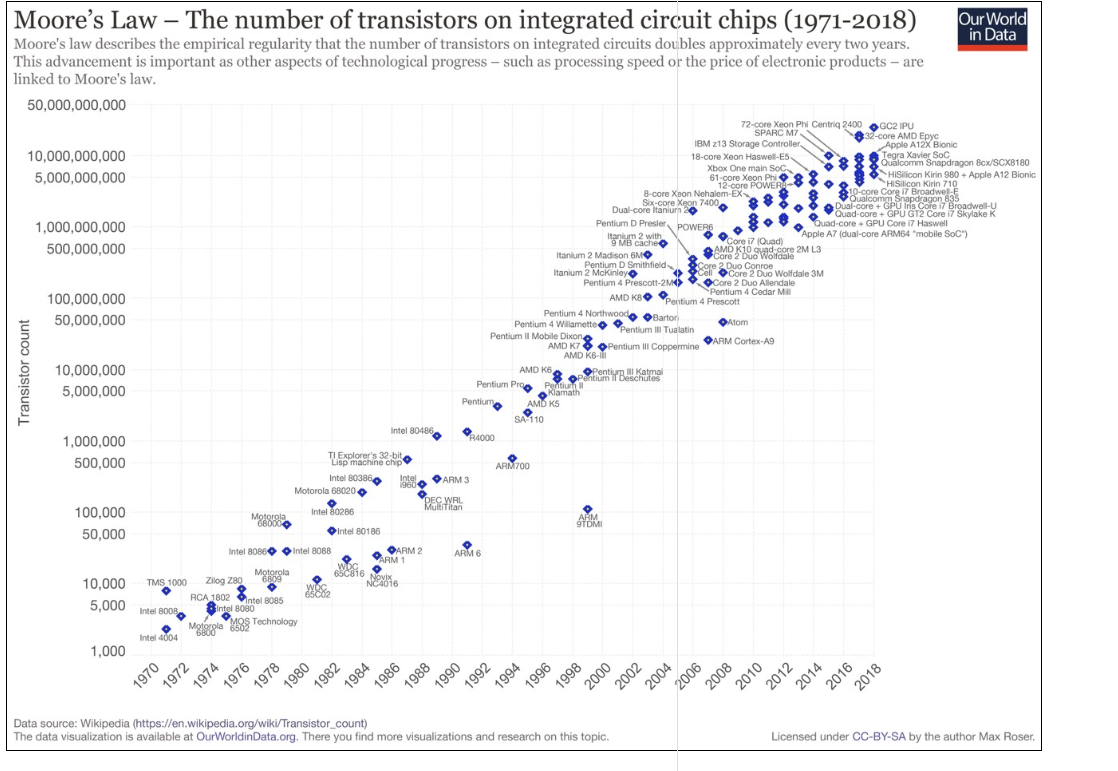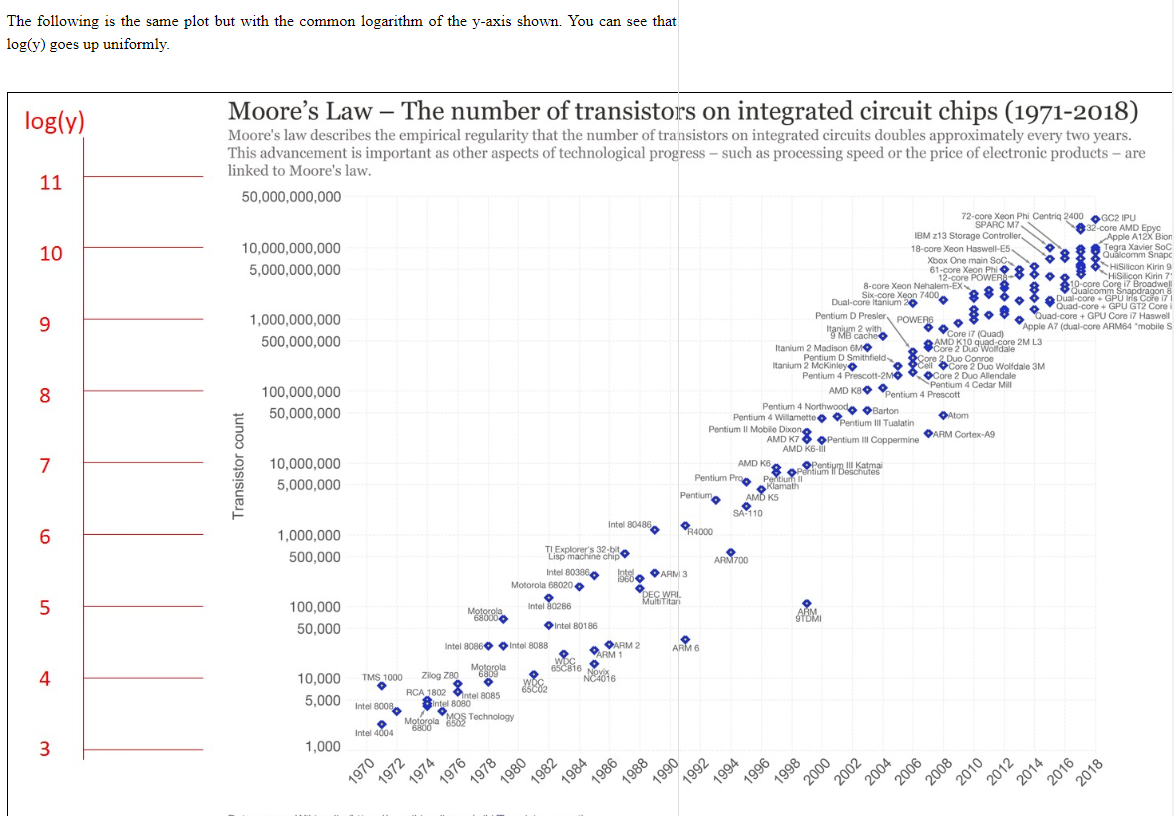Question
The following is a plot of the number of transistors per integrated circuit over the period 1971 - 2008 takenfromhttps://ourworldindata.org/technological-progress (that site contains a lot
The following is a plot of the number of transistors per integrated circuit over the period 1971 - 2008 takenfromhttps://ourworldindata.org/technological-progress (that site contains a lot of data, not just for technology). At first, this graph seems to show a steady progression until you look carefully at the y-axis ... it's not linear. Fromthe graph, it seems that from 1971 to 1981 the number of transistors went from about 1,000 to 40,000. Moore's Law predicts that in 10 years, it would double 5 times, i.e. go from 1,000 to 32,000, and the actual values (using very rough estimates) seemto support this.
Part a: The number of transistors per IC in 1972 seems to be about 4,000 (a rough estimate by eye). Using this estimate and Moore's Law, what would you predict the number of transistors per IC to be 20 years later, in 1992?
Prediction =____________
Part b: From the chart(see below), estimate (roughly) the number of transistors per IC in 2018. Using your estimate andMoore's Law, what would you predict the number of transistors per IC to be in2040?
Part c: Do you think that your 2040 prediction in Part b is technologically achievable? Why or why not?


Moore's Law - The number of transistors on integrated circuit chips (1971-2018) Moore's law describes the empirical regularity that the number of transistors on integrated circuits doubles approximately every two years. This advancement is important as other aspects of technological progress - such as processing speed or the price of electronic products - are linked to Moore's law. 50,000,000,000 10,000,000,000 5,000,000,000 Transistor count 1,000,000,000 500,000,000 100,000,000 50,000,000 10,000,000 5,000,000 1,000,000 500,000 100,000 50,000 10,000 5,000 1,000 TMS 1000 Intel 8008 100 Intel 4004 1970 1972 Motorola 68000 Motorola Zilog Z80 6809 O RCA 18028 Intel 8085 Intel 8080 Motorola M 8502 6800 1974 Intel 8086 Intel 8088 Technology 1976 Motorola 68020 1978 Intel 80286 TI Explorer's 32-bit Lisp machine chip Intel 803860 1980 82 Intel 80186 Intel 80486 1982 65C816 Novx NC4016 1984 Intel 1960- ARM 2 ARM 1 1986 NO 1988 ARM 3 DEC WRL MultiTitan Pentium 1990 Pentium II Mobile Dixon ARM 6 AMD K6 Pentium Pro Petiu Klamath R4000 Itanium 2 Madison 6MO Pentium D S Itanium 2 McKinley Pentium 4 Prescott-2M4 AMD KB Pentium 4 Northwood Barton Pentium 4 Willamette 1992 AMD K5 SA-110 ARM700 AMD K7 7 AMD K6- 1994 1996 8-core Xeon Nehalem-EX Six-core Xeon 7400 Dual-core Itaniurn 20 Pentium D Presler Itanium 2 with 9 MB cache POWERB Pentium II Katmal Pentium Il Deschutes Su ARM 9TDMI 1998 2000 Pentium Il Tualatin Pentium IIl Coppermine Data source: Wikipedia (https://en.wikipedia.org/wiki/Transistor_count) The data visualization is available at OurWorldinData.org. There you find more visualizations and research on this topic. 2002 IBM 213 Storage Controller. 18-core Xeon Haswell-E5 Soc Xbox One main Soc 61-core Xeon Phi 12-core POWER- 8 2004 72-core Xeon Phi Centriq 2400 GC2 IPU SPARC M7 32-core AMD Epyc Apple A12X Bionic Tegra Xavier SoC Core 2 Duo Conroe Cell Pentium 4 Prescott 2006 Core i7 (Quad) AMD K10 guad-core 2M L3 Core 2 Duo Wolfdale Core 2 Duo Wolfdale 3M Core 2 Duo Allendale Pentium 4 Cedar Mill Atom ARM Cortex-A9 2008 2010 2012 10-core Core i7 Broadwell-E Qualcomm Snapdragon 835 Dual-core + GPU Iris Core i7 Broadwell-U Quad-core + GPU GT2 Core i7 Skylake K Quad-core + GPU Core i7 Haswell mobile Apple A7 (dual-core ARM64 "mobile SoC") 2014 2016 Our World in Data Qualcomm Snapdragon 8cx/SCXB180 HiSilicon Kirin 980 + Apple A12 Bionic HiSilicon Kirin 710 2018 Licensed under CC-BY-SA by the author Max Roser.
Step by Step Solution
There are 3 Steps involved in it
Step: 1

Get Instant Access to Expert-Tailored Solutions
See step-by-step solutions with expert insights and AI powered tools for academic success
Step: 2

Step: 3

Ace Your Homework with AI
Get the answers you need in no time with our AI-driven, step-by-step assistance
Get Started


